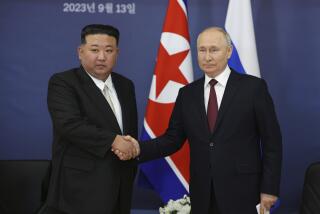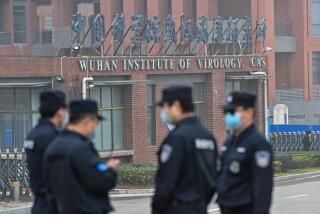U.S. intelligence divide on North Korea is exposed

- Share via
WASHINGTON — An impromptu release of a Pentagon intelligence assessment suggesting North Korea could fit a nuclear warhead atop a ballistic missile — only to see the nation’s top intelligence official say other U.S. agencies did not necessarily agree — has exposed a stark divide in America’s intelligence apparatus on the threat from Pyongyang.
The Defense Intelligence Agency, the largest of the 16 U.S. intelligence services in terms of personnel, came under fire Friday, a day after Rep. Doug Lamborn (R-Colo.) unexpectedly disclosed in a House hearing that the DIA had “moderate confidence” that Pyongyang “currently has nuclear weapons capable of delivery” by missiles.
If true, North Korea would pose a far greater threat than the White House previously has acknowledged because the Northeast Asian nation could, in theory, launch a nuclear weapon at the United States, Japan or South Korea.
But in an unusual airing of what are usually classified disagreements, officials quickly made clear that the DIA appraisal was disputed by other intelligence agencies.
“What’s going on here is the typical cultural divide” among military and civilian intelligence agencies, said Mark Lowenthal, a former top intelligence analyst at the CIA and the State Department’s intelligence arm, the Bureau of Intelligence and Research.
“The DIA,” he said, “tends to focus a lot more on military things, and they tend to get a little more excited about them.”
DIA estimates of Soviet missile strength during the Cold War, for instance, were often higher than other estimates, Lowenthal said.
The civilian CIA “tends to be more lawyerly” and demands more evidence before it reaches an affirmative judgment, said Bruce Klingner, a former CIA analyst who focused on North Korea.
To be sure, both the CIA and DIA were wrong about Saddam Hussein’s supposed stockpiles of weapons of mass destruction in Iraq. Their judgments provided a key rationale for the U.S.-led invasion in 2003, but no illicit weapons were found.
Except for the two sentences Lamborn read aloud, the DIA report on North Korea, which was prepared a month ago, remains classified. It’s unclear whether it cites evidence for the assessment.
What’s certain is that the Obama administration was not pleased. Late Thursday night, James R. Clapper, director of national intelligence, took the unusual step of issuing a public statement that slapped down the DIA.
Clapper said the DIA claim was “not an intelligence community assessment. Moreover, North Korea has not yet demonstrated the full range of capabilities necessary for a nuclear armed missile.”
The Pentagon press secretary, George Little, also swatted the agency. “It would be inaccurate to suggest that the North Korean regime has fully tested, developed or demonstrated” a weapon that could be used on a missile, he said.
The DIA has held an expansive view of Pyongyang’s warhead capabilities for some time. In March 2011, then-DIA Director Army Lt. Gen. Ronald Burgess told a Senate committee that North Korea “may now have several plutonium-based nuclear warheads that it can deliver by ballistic missiles and aircraft as well as by unconventional means.”
And in 2005, a year before North Korea conducted its first underground nuclear test, then-DIA chief Navy Vice Adm. Lowell Jacoby was asked at a Senate hearing whether Pyongyang had the ability to arm a missile with a nuclear device. He answered, “My assessment is that they have the capability to do that, yes, ma’am.”
Intelligence officials downplayed Jacoby’s comments, expressing the consensus that North Korea was years away from building nuclear-tipped missiles.
Senior administration officials repeated that view Friday.
“We do not operate under the presumption that they have that fully tested and available capacity,” Secretary of State John F. Kerry, on a visit to Seoul, told reporters when asked about the DIA report .
North Korea has conducted three underground nuclear tests, “so there’s some kind of device,” Kerry said. “But that is very different from miniaturization and delivery.”
More to Read
Sign up for Essential California
The most important California stories and recommendations in your inbox every morning.
You may occasionally receive promotional content from the Los Angeles Times.














